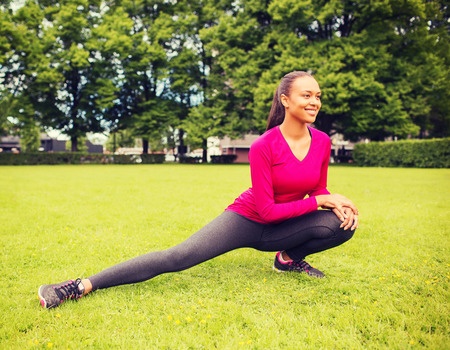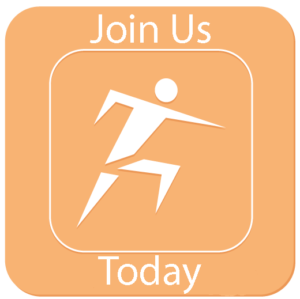Do you stretch, not just to warm up, but really stretch? The ability to perform full side splits, while beneficial, is a sign of good flexibility, and a primary goal of many martial artists, but not of the general public. The goal of achieving flexibility is sought by many, but too often neglected by most. It is important to remain flexible regardless of whether you’re a general fitness buff or a bodybuilder. The primary reasons for desiring flexibility, of which there are various stages, is for overall performance, less chance of injury, and reduced chance of fatigue.
For many, stretching can and has been very frustrating—having tried every method including all the wrong ones. There are two primary reasons for inflexibility, neither of which is genetic or requisite on muscle length. First is the lack of muscle strength or tone. Second is the performance of too much stretching. Muscles can become sore or even acquire micro tears that produce scar tissue. Scar tissue will severely limit flexibility. Many of us have probably learned this the hard way; it generally takes a while to learn that stretching about twice per week will produce the desired results with complimentary weight training three times per week. If you do not lift weights, stretching can be done 3‑4 times per week without undue stress to the muscles. However, if you lift, lifting is stretching with resistance (if done properly), so why stretch every day and lift — it is almost a certainty that you will over-stress the body.
Advertisement: Amazon (click on photo for more info)
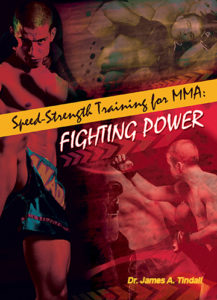 Why are muscles the key and not ligaments and joints? For years it has been known (among Olympic coaches) that the primary reason is because tension in the muscles comes from 1) connective tissues (collagen fibers, ligaments, and tendons associated with each muscle) and 2) muscle fibers themselves. As early as 1940, it was illustrated that the tension in a resting muscle is minimal unless the range of motion (extension) exceeds 130 percent of the resting length. In 1956 it was shown by researchers that connective tissues generate passive tension and for muscles that are stretched to over a 100 percent of the resting length, this tension is a small amount of that generated by active contraction—even at 120 percent of the resting length of the muscle the two components of muscle tension are about equal. After a muscle is stretched (beyond 120 percent) passive tension due to connective tissues increases but, active tension generated by muscle fiber contraction decreases. Thus, by relaxing the contracting muscles, a better and fuller stretch can be achieved. Since the early years we have come a long way—stretching has become a science, which is presented to you now.
Why are muscles the key and not ligaments and joints? For years it has been known (among Olympic coaches) that the primary reason is because tension in the muscles comes from 1) connective tissues (collagen fibers, ligaments, and tendons associated with each muscle) and 2) muscle fibers themselves. As early as 1940, it was illustrated that the tension in a resting muscle is minimal unless the range of motion (extension) exceeds 130 percent of the resting length. In 1956 it was shown by researchers that connective tissues generate passive tension and for muscles that are stretched to over a 100 percent of the resting length, this tension is a small amount of that generated by active contraction—even at 120 percent of the resting length of the muscle the two components of muscle tension are about equal. After a muscle is stretched (beyond 120 percent) passive tension due to connective tissues increases but, active tension generated by muscle fiber contraction decreases. Thus, by relaxing the contracting muscles, a better and fuller stretch can be achieved. Since the early years we have come a long way—stretching has become a science, which is presented to you now.
The core lifts and exercises that are developed within programs on this website and by trainers in general can enhance flexibility because many of the exercises given require a full range of motion of muscular groups. However, flexibility can be further increased with proper stretching exercises. The individual who has great flexibility normally has an increased blood flow through the muscles. With this enhanced blood flow comes an increase in oxygen supply that will greatly speed recovery time by healing bruised and torn muscles, lowering accumulation of lactic acid in the muscle, help loosen the muscles, and allow more oxygen into joints—there is always a reduced oxygen content in joints compared to oxygen content in muscles. And, these are important for all kinds of athletes and gym rats.
Lack of oxygen is one of the main reasons why joint injuries take so long to heal and an important reason why you would desire greater flexibility. A loose or relaxed muscle is much less susceptible to injury than a tight one. Flexibility is necessary for all, especially those who practice very rapid movements. Rapid movements are constantly the cause of hamstring tears, groin pulls and other muscular injuries in many sports, including weight lifting in the gym. Here again, we see another benefit of speed-strength training—train fast and your body is accustomed to such motions when they must be performed. Train slow and you may injure yourself because the body is not trained for rapid movements. Consequently, flexibility is something that should be desired by all, and especially for bodybuilders.
There are four different kinds of stretching that will be discussed in a later articles. These include: 1) Proprioneuromuscular Facilitation (PNF); 2) Static; 3) Dynamic; and 4) Passive Relaxed. However, before getting into details, let us examine flexibility and its definition(s) a little further. In today’s gym, the term “flexibility” is commonly thrown around with little or no understanding of the ‘how’s and why’s’ that really enhance or allow the individual to become more flexible. The most common problem causing reduced flexibility is lack of functional strength through the full range of movement of the muscle. In other words, if your muscles are not strong and able to contract at any point in the movement, the muscles are subject to rupturing. Utilizing this concept, let’s touch on different stretching techniques, their effectiveness, and some limiting factors as well.
Advertisement: Silk (click on photo for more info)
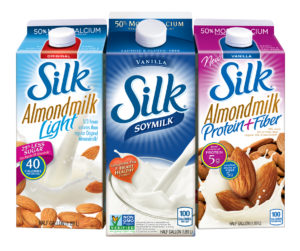 The definition of flexibility given by the International Sports Sciences Association (ISSA) is “Flexibility is your ability to flex, extend or circumduct your body’s joints through their intended, full range of motion without substantial decrement in limit strength.” Thus, strength and flexibility go together. You cannot be flexible without having strength. Have you ever noticed when you a quick movement that the specific limb will go so far then, stop and bounce back? This is a safety mechanism that “Mother Nature” built into our bodies to keep us from tearing ourselves apart—it is called the stretch reflex. Once our muscles reach a certain level of strength then, and only then is it safe to obtain a new level of flexibility. This is where a good lifting program compliments your ability to stretch the muscles. With a good lifting and stretching program, maximal flexibility is obtained. Lifting strengthens the muscles and increases the new range of motion and prevents any dangerous implication from being flexible. Consequently, it is a systematic process to become flexible, not just a stretch, stretch, stretch, and more stretch type of program. With a little knowledge and understanding of how the body works and a plan, you can achieve good flexibility.
The definition of flexibility given by the International Sports Sciences Association (ISSA) is “Flexibility is your ability to flex, extend or circumduct your body’s joints through their intended, full range of motion without substantial decrement in limit strength.” Thus, strength and flexibility go together. You cannot be flexible without having strength. Have you ever noticed when you a quick movement that the specific limb will go so far then, stop and bounce back? This is a safety mechanism that “Mother Nature” built into our bodies to keep us from tearing ourselves apart—it is called the stretch reflex. Once our muscles reach a certain level of strength then, and only then is it safe to obtain a new level of flexibility. This is where a good lifting program compliments your ability to stretch the muscles. With a good lifting and stretching program, maximal flexibility is obtained. Lifting strengthens the muscles and increases the new range of motion and prevents any dangerous implication from being flexible. Consequently, it is a systematic process to become flexible, not just a stretch, stretch, stretch, and more stretch type of program. With a little knowledge and understanding of how the body works and a plan, you can achieve good flexibility.
Benefits of Stretching
Many desire to be able to perform a full side split and, I know lots of big tough bodybuilding men an women, in addition to fighters who can. On the other hand, most may believe, “I’ll never be able to do that”, which is probably true unless they are performing proper training routines. By understanding the benefits of stretching, you will more clearly understand the purpose of the stretch and when various stretches should be performed.
For most, the overall purpose of stretching is to achieve greater flexibility. If a person is going to be a great athlete in any sport, flexibility is an essential motor skill. For athletes that perform in football, soccer, baseball, or other sports, a good amount of flexibility is essential. If on the other hand you’re involved in yoga, MMA, UFC, martial arts, etc., just to perform the most basic maneuvers and techniques well, good flexibility is paramount. Individually, the amount of natural flexibility each person has will vary, but can be enhanced through proper stretching. Any full range of motion exercise will increase flexibility to an extent, but you must choose exercises that do not interfere with the development and performance of translations of skills from gym to stage or field of play. Learn to make each workout count towards improving individual flexibility.
In addition to improving the range of motion of your joints, stretching can enhance breathing regulation, be a good warm-up or warm-down exercise, speed recovery, increase oxygen supply (by increasing blood flow) to the muscles, reduce or relieve muscle spasms, and reduce muscle tension. The reader has heard or probably will hear all kinds of advice on stretching. The idea is to recognize good advice from poor advice. Adhering to poor advice can result in not achieving the desired flexibility and in injury. It is important to remember that stretching, just as with your workout programs, is both an art and a science. Physiologically and physically, the body will perform most movements required of it and can also be trained to learn many other movements. The latter is one of the primary benefits of stretching. Stretching will improve agility, balance, power and strength.
Stretching and Age
One limit on flexibility is age. A younger person will generally be more flexible than an older person and in younger persons, ligament elongation can normally occur in a good flexibility program. Older persons are generally less flexible primarily because scar tissue may have been formed that attaches itself to surrounding muscles and joints prohibiting or greatly reducing movement. Another limiting factor of flexibility is shortened muscles and fibers due to lack of inactivity or performance of exercises for long periods of time that do not work a full range of motion, i.e., jogging, bicycling, etc. These factors can prevent you from performing a split or lofty front stretch or kick. If you have been inflexible for 20 years, it is going to take a while to reach a high level of flexibility, but this goal can be achieved through careful planning and a little work each day using properly combined speed‑strength and flexibility training. And, as you age, it is important to maintain flexibility to avoid using canes and wheel chairs. How many of you have parents? Help them with this and show them the importance of staying as flexible as they can.
While age may be a limit to flexibility, it is certainly not insurmountable because neither ligament length nor joint structure is responsible for limiting flexibility. For example, if you were to perform a front split stretch, sometimes called a runner stretch (much easier to begin with than a side split), an inflexible person would have difficulty touching the front thigh of the rear leg to the floor. Failure to complete the stretch would most likely arise because the iliofemoral ligament is not relaxed. By tilting the pelvis forward (or moving the thigh to the front) relaxation can occur, but it is still likely that the hamstring (front leg), lower back muscles, and hip flexors will have to become more flexible to complete the stretch. Thus, it will take some time to get back into stretching if you have not stretched for a while.
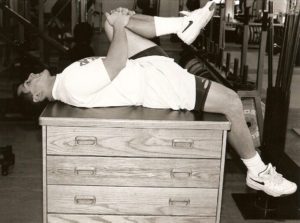 The hip flexor (iliopsoas) usually contracts strongly with increased age and becomes much less flexible than during your youth. To test if the hip flexor needs some good stretching, lie flat on your back (preferably on a table with the edge in the back of both knees so the feet cannot touch the floor – see photo). Next, lift one knee until it touches the chest. As the knee is pressed towards the chest, an angle will be created between both thighs. If the leg lying on the table begins to move upwards (off the table) before the angle between the thighs is 120°, the hip flexors are not as flexible as they need to be to perform the front split stretch.
The hip flexor (iliopsoas) usually contracts strongly with increased age and becomes much less flexible than during your youth. To test if the hip flexor needs some good stretching, lie flat on your back (preferably on a table with the edge in the back of both knees so the feet cannot touch the floor – see photo). Next, lift one knee until it touches the chest. As the knee is pressed towards the chest, an angle will be created between both thighs. If the leg lying on the table begins to move upwards (off the table) before the angle between the thighs is 120°, the hip flexors are not as flexible as they need to be to perform the front split stretch.
To test if you can do a full side split, simply stand next to a chair or table and see if; by placing the foot on the chair or table (toes pointing up), a 90° angle can be formed between the thighs (see photo below). If you can do this, a good stretching program will allow you to perform a full split. Remember, it is not the ligaments or joint structure, and therefore hip structure in this instance that hinders your flexibility. Having strong muscles and relaxing the tension of muscles surrounding each joint and muscle strength is the key to great flexibility, especially for older practitioners!
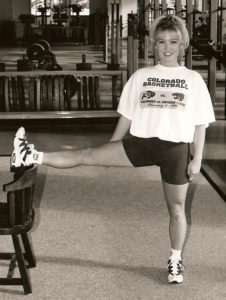
Stretching is paramount to better fitness and health, as well as to avoid more common injuries. So, make sure you add some stretching in your workout programs. Until next time when we discuss types of stretching – have a happy and healthy day.






